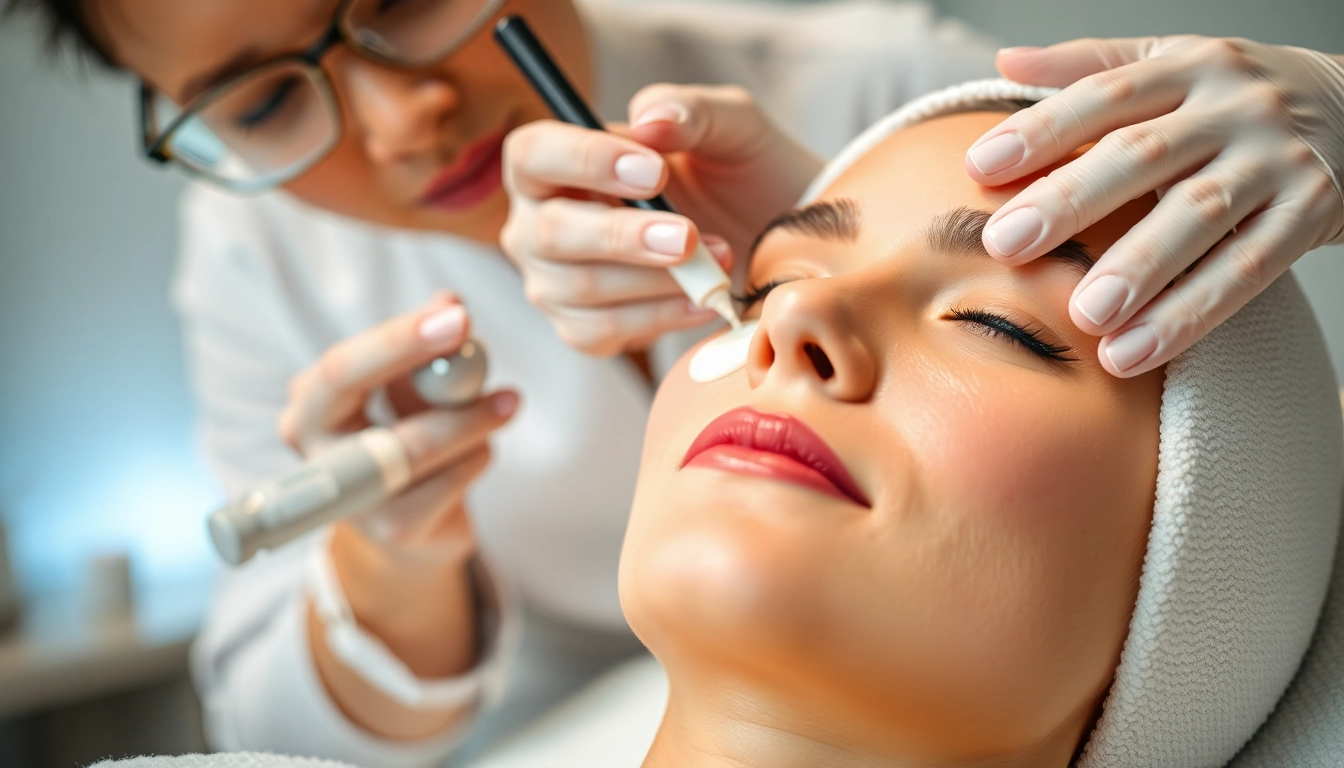Understanding Chemical Peels
What are Chemical Peels?
Chemical peels are cosmetic treatments designed to enhance the appearance of the skin by applying a solution that causes the outer layers of the skin to exfoliate and eventually peel off. The key idea is to remove damaged skin, allowing fresh, new skin to emerge. This procedure is popular for its ability to address various skin concerns, including hyperpigmentation, fine lines, wrinkles, and acne scars. The solutions used in chemical peels can vary in strength and formulation, making it essential to understand the process and what to expect before undergoing treatment. If you are considering chemical peels, it’s crucial to have a comprehensive understanding of how they work and what they entail.
Types of Chemical Peels Explained
Chemical peels fall into three main categories: superficial peels, medium peels, and deep peels. Each type is suitable for different skin concerns and provides varying degrees of exfoliation.
- Superficial Peels: These peels use mild acids, such as alpha-hydroxy acids (AHAs), to gently exfoliate the outer layer of skin. They are ideal for treating minor skin issues like dry skin and sun damage. Superficial peels often require little to no recovery time.
- Medium Peels: Using stronger acids, such as trichloroacetic acid (TCA), medium peels penetrate deeper into the skin. They are effective for more pronounced issues, including moderate wrinkles and acne scars. Recovery time typically lasts about a week, during which the skin will peel and flake.
- Deep Peels: These involve more potent acid solutions, such as phenol, to target deeper layers of skin. Deep peels are used for severe skin imperfections and require longer recovery times, usually several weeks. They can significantly improve skin texture but require careful aftercare and consideration of potential side effects.
Benefits of Chemical Peels for Skin Health
Chemical peels offer numerous benefits for skin health, including:
- Improved Skin Texture: By removing dead skin cells, chemical peels reveal smoother skin underneath, enhancing overall texture.
- Even Skin Tone: Peels can significantly reduce hyperpigmentation and uneven skin tone, promoting a more uniform complexion.
- Minimized Fine Lines and Wrinkles: Regular chemical peels can help reduce the appearance of fine lines, providing a more youthful look.
- Reduced Acne and Scarring: Certain chemical peels are effective in managing acne breakouts and minimizing the visibility of acne scars.
- Boosted Collagen Production: Many chemical peels stimulate collagen production, leading to firmer, more resilient skin over time.
Choosing the Right Chemical Peel for You
Factors to Consider Before Treatment
Before deciding on a chemical peel, it’s essential to consider several factors:
- Skin Type: Different skin types may react differently to various chemical peels. For instance, those with sensitive skin might benefit more from superficial peels.
- Skin Concerns: Identify the specific skin issues you wish to address, such as acne, discoloration, or signs of aging, to guide your choice of peel.
- Medical History: Previous skin treatments, allergies, or certain medical conditions can affect the suitability of a peel. Be transparent with your aesthetician about your medical history.
- Desired Outcomes: Understand what results you aim to achieve, and ensure these align with the potential outcomes of the chosen peel.
Skin Types and Chemical Peels
Different skin types can respond distinctly to chemical peels. It’s vital to choose a peel that will complement your specific skin type:
- Oily Skin: Often responds well to medium to deep peels, which can help manage acne and control oil production.
- Dry Skin: Superficial peels may be more appropriate, as they are less aggressive and focus on hydrating the surface.
- Sensitive Skin: A gentler approach, like a superficial peel with milder acids, is preferable to avoid irritation.
- Combination Skin: Those with combination skin may require a tailored approach, using different peel types on various areas.
Consultation: What to Discuss with Your Aesthetician
A thorough consultation with your aesthetician is vital for a successful chemical peel experience. During the consultation, discuss:
- Your skin type and any concerns you’ve been facing.
- Your expectations and desired outcomes from the treatment.
- Any previous skin treatments and medications.
- Potential side effects and recovery time.
This open dialogue will ensure a personalized treatment plan that aligns with your skincare goals.
Preparation and Aftercare for Chemical Peels
Pre-Treatment Guidelines
Proper preparation before a chemical peel can enhance results and reduce complications. Here are essential pre-treatment guidelines:
- Avoid Sun Exposure: Limit sun exposure for at least a week prior to your peel, as it can increase sensitivity and risk of complications.
- Stop Certain Medications: Consult your aesthetician regarding any medications that may increase skin sensitivity, such as retinoids or blood thinners.
- Hydrate Your Skin: Use a good moisturizer leading up to your treatment to ensure your skin barrier is healthy.
- Follow Any Specific Instructions: Your aesthetician may provide tailored guidance based on your skin type and the specific peel being used.
Post-Peel Care: Dos and Don’ts
After a chemical peel, proper aftercare is essential for optimal healing. Here’s a list of dos and don’ts:
Dos:
- Follow your aesthetician’s aftercare instructions carefully.
- Moisturize your skin regularly to prevent excessive dryness.
- Use gentle cleansers and avoid scrubbing your skin for the first few days.
- Apply sunscreen diligently to protect your peeling skin from UV damage.
Don’ts:
- Avoid picking at peeling skin, as this can lead to scarring or infection.
- Refrain from using harsh skincare products, including exfoliants or acids, until your skin has fully healed.
- Stay away from vigorous workouts that can induce sweating during the initial recovery period.
Managing Side Effects and Healing Process
Post-peel, it’s normal to experience some mild side effects. Here’s how to manage the healing process:
- Redness and Swelling: These symptoms typically subside within a few days. Apply cool compresses to soothe the skin.
- Peeling: Allow the skin to naturally peel. Avoid pulling off any skin flakes.
- Consult If Severe Symptoms Arise: If you experience excessive redness, swelling, or signs of infection, reach out to your aesthetician or dermatologist promptly.
Tips for Optimal Results from Chemical Peels
Frequency of Treatments
To achieve the best outcomes, consider the following regarding treatment frequency:
- Superficial Peels: These can be done regularly, often every 4 to 6 weeks.
- Medium Peels: Typically recommended every 3 to 6 months, based on skin response and the condition being treated.
- Deep Peels: Usually reserved for once every few years due to the more significant effects and longer recovery time.
Always consult with your aesthetician regarding the optimal schedule for your specific skin needs.
Combining Chemical Peels with Other Treatments
Many individuals find that combining chemical peels with other treatments enhances their overall skin health:
- Microneedling: This combination can promote deeper penetration of serums and enhance collagen production.
- Laser Treatments: Using laser therapy can complement the effects of deeper peels for more pronounced results.
- Hydrafacial: Many find that a Hydrafacial following a peel helps to clear out remaining debris and deeply hydrate the skin.
Discuss potential combinations with your aesthetician to create a tailored regimen that meets your skin goals.
Maintaining Your Skin Between Peels
Post-treatment care and consistent daily routines are pivotal for maintaining results from chemical peels:
- Daily Sunscreen Use: Apply broad-spectrum SPF of at least 30 every day to safeguard your skin.
- Hydration: Maintain a hydrating skincare routine, using moisturizers rich in hyaluronic acid or glycerin.
- Gentle Cleansing: Cleanse your face with a gentle, non-irritating cleanser to prevent stripping the skin of essential oils.
- Follow Up Treatments: Consider routine maintenance treatments as advised by your aesthetician to sustain results.
Final Thoughts on Chemical Peels
Long-Term Skincare Benefits of Chemical Peels
Chemical peels offer a variety of long-term benefits for skin health:
- Consistent Results: Regular treatments can lead to significant, lasting improvements in skin texture, tone, and elasticity.
- Prevention of Aging Signs: By promoting cell turnover and collagen production, they can help stave off the visible signs of aging.
- Boosted Confidence: Many individuals experience a boost in self-esteem as their skin improves, feeling better in their skin overall.
When to Seek Professional Advice
If you are unsure whether chemical peels are suitable for you, consider consulting a board-certified dermatologist or skincare professional. They can assess your skin type, discuss your goals, and recommend the best course of action. Additionally, if you encounter adverse effects post-treatment or experience any unusual symptoms, seeking advice promptly is crucial.
Empowering Your Skincare Journey with Chemical Peels
Navigating the journey toward healthier skin can feel overwhelming, but understanding chemical peels can empower your decision-making process. Always prioritize professional guidance when selecting the type of peel that suits your skin best. By adhering to pre- and post-treatment care, actively participating in consultation discussions, and committing to a healthy skincare routine, you can reap the substantial benefits chemical peels offer. Remember that beautiful skin is not just a destination but a continuous journey.



